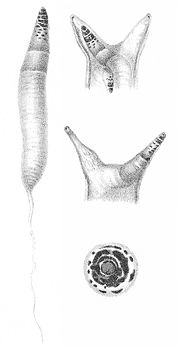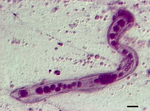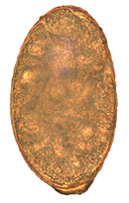 | secretory and absorptive functions. The life cycle of a typical trematode begins with an egg. Some trematode eggs hatch directly in the environment (water)... 9 KB (941 words) - 03:46, 1 March 2024 |
Miracidium (redirect from Trematode miracidium) The miracidium is the second stage in the life cycle of trematodes. When trematode eggs are laid and come into contact with fresh water, they hatch and... 7 KB (901 words) - 03:44, 1 March 2024 |
 | Jellyfish (redirect from Jellyfish Life Cycle) medusa stage in their life cycle. The basic cycle is egg, planula larva, polyp, medusa, with the medusa being the sexual stage. The polyp stage is sometimes... 118 KB (12,317 words) - 17:25, 6 April 2024 |
 | Digenea (redirect from Digenetic trematode) Digenea (Gr. Dis – double, Genos – race) is a class of trematodes in the Platyhelminthes phylum, consisting of parasitic flatworms (known as flukes) with... 24 KB (2,488 words) - 17:12, 17 October 2023 |
 | Fasciola hepatica (section Life cycle) known as the common liver fluke or sheep liver fluke, is a parasitic trematode (fluke or flatworm, a type of helminth) of the class Trematoda, phylum... 42 KB (4,416 words) - 12:41, 4 February 2024 |
 | Trematodiasis (redirect from Food borne trematode) food that is contaminated with trematodes in the larval stages of their life cycle. In a host organism, eggs of trematodes can spread through faeces, and... 23 KB (2,564 words) - 05:57, 18 April 2024 |
 | Leucochloridium paradoxum (section Life cycle) share a similar life cycle. They are parasites of snails and birds. This is a truncated life cycle compared with typical trematodes, because the snail... 15 KB (1,526 words) - 21:18, 2 March 2024 |
Heterobilharzia (section Cycle) starts the life cycle for the next generation. Heterobilharzia americana Prince 1929 (Price, Emmett W. 1929. A synopsis of the trematode family Schistosomidae... 3 KB (353 words) - 00:30, 20 December 2023 |
 | Alaria (flatworm) (redirect from Alaria (trematode)) Alaria is a genus of flatworms, or trematodes, in the family Diplostomidae. Alaria is a genus of small parasitic worm about 2–6 mm long and approximately... 5 KB (684 words) - 20:32, 2 April 2024 |
 | Liver fluke is a collective name of a polyphyletic group of parasitic trematodes under the phylum Platyhelminthes. They are principally parasites of the... 8 KB (916 words) - 22:34, 2 September 2023 |
Ribeiroia ondatrae (section Life cycle) amphibian larval stage. R. ondatrae is a digenetic trematode that occurs in lentic aquatic environments and has a complex life cycle that requires the... 9 KB (1,096 words) - 03:27, 27 April 2024 |
 | Dicyemida (section Life cycle) reproduction of sporocysts or rediae in larval trematode infections of snails. As with the trematode asexual stages, a few nematogens can usually be found in... 10 KB (1,067 words) - 16:41, 25 March 2024 |
 | Echinostoma (section Life cycle) is a genus of trematodes (flukes), which can infect both humans and other animals. These intestinal flukes have a three-host life cycle with snails or... 20 KB (1,874 words) - 05:12, 25 March 2024 |
Microphallus (section Life cycle) Microphallus is a genus of parasitic trematodes (flukes) in the family Microphallidae. The Greek name means "tiny penis". They are parasitic on a variety... 5 KB (549 words) - 18:16, 6 December 2021 |
Halipegus eccentricus (section Life cycle) definitive host, although its life cycle involves other hosts, as is common for trematodes. Earlier research proposed that its life cycle involved two other species... 5 KB (655 words) - 14:50, 1 May 2023 |
 | Gastropod-borne parasitic disease (section Trematodes) intestinal trematode genus, Brachylaima, which infects various animals and one species (B. cribbi) known to infect humans. The life cycle of Brachylaima... 43 KB (4,985 words) - 10:08, 10 January 2024 |
 | Schistosoma haematobium (section Life cycle) Schistosoma haematobium (urinary blood fluke) is a species of digenetic trematode, belonging to a group (genus) of blood flukes (Schistosoma). It is found... 28 KB (3,470 words) - 04:19, 27 April 2024 |
Coitocaecum parvum (section Life cycle) the progenetic trematode, Coitocaecum parvum (Opecoelidae). Molecular Ecology Notes 7:694-696 Lagrue, C. and R. Poulin. 2007. Life cycle abbreviation in... 5 KB (645 words) - 17:47, 1 October 2022 |
 | Cestoda (section Life cycle) gut or body wall to reach the coelom) are intestinal, though some life cycle stages rest in muscle or other tissues. The definitive host is always a vertebrate... 38 KB (3,739 words) - 18:55, 26 April 2024 |
 | Parasitic worm (section Reproduction and life cycle) reproduce entirely within their host's body; they have a life cycle that includes some stages that need to take place outside of the host. Helminths are... 32 KB (3,713 words) - 05:13, 10 January 2024 |
 | Strongyloides stercoralis (section Life cycle) life cycle without the involvement of another host) and multiplication within the host. The parasitic cycle is homogonic, while the free-living cycle... 25 KB (3,014 words) - 05:17, 9 February 2024 |
 | Bucephalus polymorphus (section Life cycle) 19:81-94, 1991. Lajtner et al.: "The effects of the trematode Bucephalus polymorphus on the reproductive cycle of the zebra mussel Dreissena polymorpha in the... 9 KB (1,099 words) - 00:02, 24 August 2022 |
 | Schistosoma mansoni (section Life cycle) the Caribbean, Brazil, Venezuela and Suriname. Unlike other flukes (trematodes) in which sexes are not separate (monoecious), schistosomes are unique... 57 KB (6,881 words) - 21:36, 17 February 2024 |
Ribeiroia (category Trematode genera) Ribeiroia (/raɪˈbɪəriːə/) is a genus of trematode parasites that sequentially infect freshwater snails in the family Planorbidae (ramshorn snails) as... 23 KB (3,016 words) - 19:55, 24 September 2023 |
 | Dicrocoelium dendriticum (section Life cycle) There is some evidence connecting decreased liver function from the trematode infection with pregnancy toxaemia and mastitis in ewes when combined with... 18 KB (1,990 words) - 12:36, 31 January 2024 |





